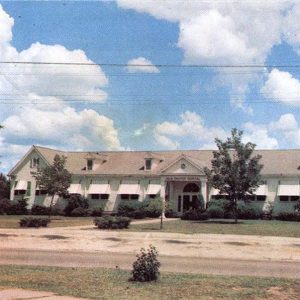calsfoundation@cals.org
Clinton Birthplace
aka: President William Jefferson Clinton Birthplace Home National Historic Site
aka: Bill Clinton Birthplace
William Jefferson Clinton, the forty-second president of the United States, lived the first four years of his life in his grandparents’ home at 117 South Hervey Street in Hope (Hempstead County). Since June 1997, known as the President William Jefferson Clinton Birthplace Home National Historic Site, has been open to the public as a museum.
The house was built in 1917 for Dr. H. S. Garrett, who evidently designed the house to imitate his previous dwelling in France. The two-and-a-half-story, 2,100-square-foot building contains six rooms, including a kitchen, living room, bedroom, and the nursery where Clinton slept. The house was purchased in 1938 by Eldridge Cassidy and Edith Grisham Cassidy, Clinton’s grandparents. Their daughter, Virginia Cassidy Blythe, made her home with them after the death of her husband, William Jefferson Blythe III, while she was still expecting their only child.
Bill Clinton was not actually born in the house now called his birthplace, but rather at Julia Chester Hospital in Hope. That hospital building no longer stands, but a plaque marks the spot where it once existed. Clinton’s grandparents raised him in their home while their daughter studied nursing in New Orleans, Louisiana. When she married Roger Clinton, the Clintons acquired a house at 321 East 13th Street in Hope in 1950 and then moved to Hot Springs (Garland County) in 1953. The Cassidys continued to own the house on South Hervey Street until 1956.
The house passed through other owners and was vacant after 1992, when it had been damaged by an electrical fire. After Clinton was elected president, a foundation was formed to acquire the house, restore it, and make it into a museum. The Clinton Birthplace Foundation sought to raise $1.5 million over five years, forty percent of which was intended to create an endowed fund to maintain the house for perpetuity. Some controversy was ignited when accusations were made that wealthy donors, some from other nations, hoped for favors from the president’s administration because of their gifts to the foundation.
The house was added to the National Register of Historic Places on May 19, 1994, bypassing the usual rule that a structure must have achieved significance more than fifty years before being registered. An exception to the fifty-year benchmark was granted because (according to the nomination form) the home was “the single property most significantly and exclusively associated with President William Jefferson Clinton’s humble beginnings, the inner strength that he learned from his mother, and the dedication to purpose that has sustained him throughout his distinguished career.” The Clinton Birthplace is one of roughly 2,000 structures among the more than 80,000 places on the register to receive such an exception.
The Clinton Birthplace Foundation first had to repair the foundation and roof of the house, weather-proof it, and add new siding. When this was completed, it began to acquire furniture and decorations to restore the interior to its appearance in the late 1940s. The president’s mother and former neighbors described the house as they remembered it, and some residents of Hope contributed furniture and other articles for the museum. A visitor center was added outside the house, and a rose garden dedicated to Virginia Kelley, Clinton’s mother (who had married Richard Kelley in 1982 and had died in 1994), was planted. The museum was opened to the public on June 1, 1997. In December 2010, it was designated a National Historic Site by the U.S. Secretary of the Interior.
On December 25, 2015, it was reported that an overnight fire had heavily damaged the home, and investigators suspected arson as the cause of the fire. The home was closed for approximately seven months due to repairs, reopening finally on July 30, 2016.
For additional information:
President William Jefferson Clinton Birthplace Home National Historic Site. National Park Service. https://www.nps.gov/wicl/index.htm (accessed July 8, 2025).
Christ, Mark K., and Cathryn H. Slater. Sentinels of History: Reflections on Arkansas Properties on the National Register of Historic Places. Fayetteville: University of Arkansas Press, 2000.
“Bill Clinton Birthplace.” National Register of Historic Places nomination form. On file at Arkansas Historic Preservation Program, Little Rock, Arkansas. Online at https://www.arkansasheritage.com/arkansas-historic-preservation-program (accessed July 8, 2025).
Hillier, Michelle. “Rebuilding the Birthplace: 2nd Phase of Project on Clinton Home Starts.” Arkansas Democrat-Gazette, February 20, 1996, pp. 1B, 6B.
Pierce, Ray. “Politics Shunned as Group Opens Door to Restore Clinton’s 1st home.” Arkansas Democrat-Gazette, June 20, 1995, pp. 1B, 5B.
Wolfe, Frank. “Clinton Home Takes Visitors Back in Time.” Arkansas Democrat-Gazette, June 1, 1997, pp. 1A, 14A.
Bill Norman
Little Rock, Arkansas
Staff of the CALS Encyclopedia of Arkansas











Comments
No comments on this entry yet.